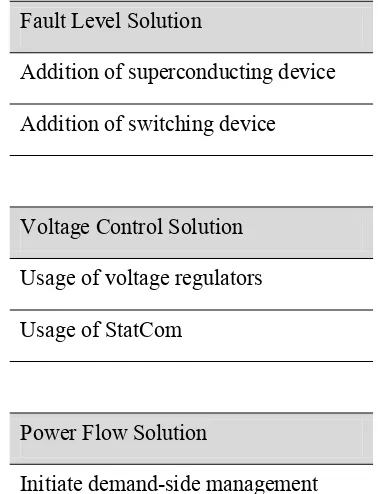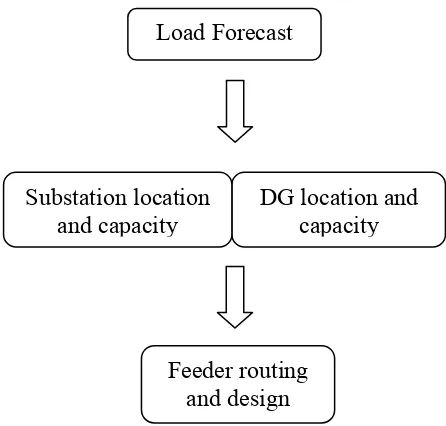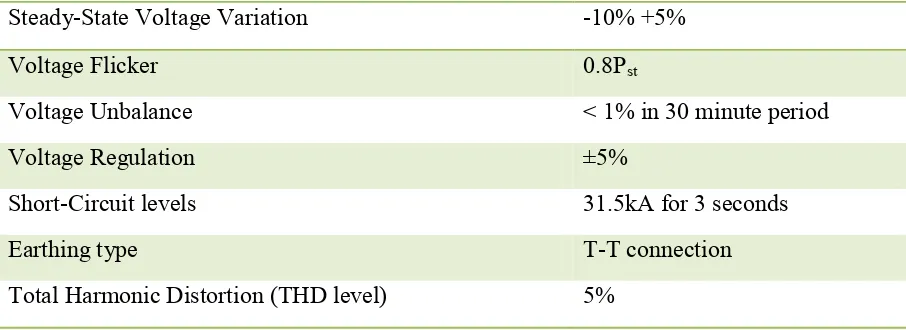SYSTEM INTEGRATION OF PV IN MALAYSIA DISTRIBUTION NETWORKS
Kee Swee Yen
ii
“I hereby declare that I have read through this report entitled “System Integration of PV in Malaysia Distribution Networks” and found that it has comply the partial fulfillment for
awarding the degree of Bachelor Electrical Engineering (Industrial Power)”
Signature :
Supervisor’s Name :
iii
SYSYTEM INTEGRATION OF PV IN MALAYSIA DISTRIBUTION NETWORKS
KEE SWEE YEN
A report submitted in partial fulfillment of the requirement for the degree of Bachelor of Electrical Engineering (Industrial Power)
Faculty of Electrical Engineering
UNIVERSITI TEKNIKAL MALAYSIA MELAKA
iv
I hereby declare that this report entitled “System Integration of PV in Malaysia Distribution Networks” is the result of my own research except cited in the references. This report has not been accepted for any degree and is not concurrently submitted in candidature of any other degree.
Signature :
Name :
v
ACKNOWLEDGEMENT
This thesis could not have been completed without my supervisor, Dr. Gan Chin Kim, for his exceptional understanding and in-depth knowledge on the research. Thank you so much for your guidance and encouragement throughout the entire final year project. I enjoyed myself immensely being able to work together with you. Thank you Sir!
Secondly, I would like to convey my utmost appreciation to my Industrial Power Head of Department, Mr. Khairul Anwar and TNB Melaka Tengah Distribution Head of Department, Mr. Muhammad Fauzi bin Zamin, for contributing the network topologies for this research. Thank you.
I would also like to thank Mr. Khairil Zambri for his assistance in PSCAD. His familiarity with the software was extremely helpful in clarifying my simulation results.
vi
ABSTRACT
vii
ABSTRAK
viii
PUBLICATIONS
As the result of this project, one conference paper has been published in the 3rd International Conference on Engineering & ICT (ICEI2012) and published in the electronic version of the conference proceedings. Details for reference are as below. For the full paper, please refer to Appendix C.
S.Y. Kee and C.K. Gan, Impact Assessment of PV on Malaysia Distribution Network,
Proceedings of the 3rd International Conference on Engineering & ICT, pp. 283-286,
2012.
ix
1.5 Project Significance 2
2 LITERATURE REVIEW
2.1 Overview 3
2.2 PV Around the World 3
2.3 PV in Malaysia 3
2.4 PV Drivers and Benefits 4
2.5 Theory on Large-Scale PV Technical Impacts
2.5.1 Reverse Power Flow 5
2.5.2 Voltage Deviation 5
2.6 Smart Integration of PV 5
2.7 Cost and Benefits 7
x
CHAPTER TITLE PAGE
2.7.1.1 Implications of Network
Reinforcement 7
2.7.2 Active management 8
2.8 Distribution Networks 9
2.8.1 Distribution System Planning with High
PV Capacity 9
2.9 Malaysia Statutory Requirement for Network Design 10
3 METHODOLOGY
3.1 Overview 11
3.2 Data Acquisition 12
3.2.1 Distribution Network Topology 12
3.2.1.1 Residential Network Topology 12 3.2.1.2 Commercial Network Topology 13 3.2.1.3 Industrial Network Topology 14
3.2.2 Load Profiles 13
3.2.2.1 Residential Load Profiles 15 3.2.2.2 Commercial Load Profiles 16 3.2.2.3 Industrial Load Profiles 17
3.3 Software Modeling 18
4.2 Uniformed PV Integration
4.2.1 Voltage Rise 22
xi
CHAPTER TITLE PAGE
4.3 Non-uniformed PV Integration 28
5 ANALYSIS AND DISCUSSIONS
5.1 Voltage Rise 29
5.2 Power Losses 30
5.3 Comparative Analysis 30
5.3 Cost Analysis 31
6 CONCLUSIONS AND RECOMMENDATIONS 32
7 REFERENCES 34
xii
LIST OF TABLES
TABLE TITLE PAGE
2.1 Solutions for network reinforcements 6
2.2 TNB standards for distribution network planning 10
3.2 Comparison of different topologies load profiles 17 5.1 Typical network parameters of the UK and Malaysia
xiii
LIST OF FIGURES
FIGURE TITLE PAGE
2.2 Classical Approach 8
2.3 Active Network Planning 8
3.1 Methodology Flow Chart 11
3.2 Residential Network Topology 13
3.3 Commercial Network Topology 14
3.4 Industrial Network Topology 15
3.5 Residential Topology Load Profile 16
3.6 Commercial Topology Load Profile 16
3.7 Industrial topology Load Profile 17
3.8 One-line Case Study 1 without PV penetration 19
3.9 Three-phase Case Study 1 without PV penetration 19
3.10 One-line Case Study 2 without PV penetration 19
3.11 Three-phase Case Study 2 without PV penetration 20
3.12 One-line Case-Study 3 without PV penetration 20
3.13 Three-phase Case Study 3 without PV penetration 20
3.14 Power injection PV Module 21
4.1 One-line Case Study 1 at 100% PV penetration 22
4.2 Three-phase Case Study 1 at 100% PV penetration 23
4.3 One-line Case Study 2 at 100% PV penetration 23
4.4 Three-phase Case Study 2 at 100% PV penetration 24
4.5 One-line Case Study 3 at 100% PV penetration 24
4.6 Three Phase Case Study 3 at 100% PV penetration 25
4.7 Voltage levels in increasing PV penetration 25
4.8 Power Losses for Case Study 1 26
4.9 Power Losses for Case Study 2 27
xiv
LIST OF APPENDIXES
APPENDIX TITLE PAGE
A Transmission Line Settings 38
B Analysis Data 39
C ICEI 2012 Conference Paper 41
CHAPTER 1
INTRODUCTION
1.1 Overview
This thesis is organized in six chapters. Chapter 1 describes the project objectives as well as the project scope which defines the area of research. Chapter 2 reviews the past researches regarding PV integration into low-voltage networks, covering the cost and benefits of PV integration and also the technical impacts of high PV penetration in the grids. The literature review also addresses the important theories and concepts as well as equations related to the entire project. Chapter 3 presents the methodology of the project, and how each procedure is executed to achieve the objectives. Chapter 4 illustrates all the simulation results while Chapter 5 discusses and analyzes the obtained data. Chapter 6 concludes findings and suggests recommendations for future research.
1.2 Problem Statement
2
1.3 Objectives
The two main objectives of this final year project are as follows :
1) To study the cost and benefits of PV integration in Malaysia distribution networks. 2) To investigate the technical impacts of different levels of PV penetration on
different distribution network topologies in Malaysia using software modeling.
1.4 Project Scope
Two distribution networks will be used for this project; residential and commercial networks. The case study will be carried out using Malaysia distribution networks therefore the data will be obtained from the local electrical utility, Tenaga Nasional Berhad (TNB).
Different levels of PV penetration will be modeled in two conditions: i. Uniformly distributed PV integration
ii. Non-uniformly distributed PV integration
The technical impacts will be assessed in terms of voltage changes and power flows. As for the cost and benefits of PV integration, literature reviews will be done on existing PV researches.
1.5 Project Significance
CHAPTER 2
LITERATURE REVIEWS
2.1 Overview
This section of the report encompasses the growth of PV applications around the world and in Malaysia. It will also include studies on PV drivers, cost and benefits. The impacts of large-scale PV integration were also discussed, as well as the solutions to mitigate the impacts. These reviews are documented in nine sub topics.
2.2 PV Around the World
There are approximately 40,000 MW of photovoltaic (PV) installations around the globe in 2010 [1]. Germany has shown the world that environmental and industrial development can be achieved simultaneously when the Germans introduced the first FiT (Feed-in Tariff) and has the largest PV market world-wide, with 3.8GW in 2009 [1]. Among the solar PV pioneers are; Japan with 99% grid-connected 2.6GW of solar power in 2009 and USA with an estimated 3GW of PV installations in 2014 [1][2]. According to S. Strong [3], building-integrated PV systems (BIPV) will be the prime PV application for early PV market penetration and it is, without a doubt, proven to be true in [4]-[12] where BIPV is widely installed in Europe, Japan and United States. PV technology is advancing day by day and just recently, ArrayPower [13] has introduced a cost-optimized integrated AC module where the PV modules and integrator comes in a single component, for easy installation and maintenance.
2.3 PV in Malaysia
4
areas. The five-year MBIPV project [14] has created a solid foundation BIPV market by achieving a 440% increase in solar BIPV system application from year 2005 to 2010 [15]. According to the Tenth Malaysia Plan, the BIPV application is expected to be more economically viable by 2017 thus enabling end-users to have a cheaper, reliable supply of electricity with reduced losses as well as reducing the energy demand peak. Feed-In Tariff (FiT) is introduced to help develop new markets for the PV industry and Malaysia already has her very own FiT mechanism under the Renewable Energy Act, which commenced on 1st December 2011. BIPV end-users will have a chance to sell generated PV to power utilities for a specific duration at a fixed premium price. For PV installations, the the FiT duration is 21 years, rating from Rm1.25 - 1.75 per kWh with annual degression of 8% to promote grid parity [16]-[18].
2.4 PV Drivers and Benefits
5
2.5 Theory on Large-Scale PV Technical Impacts
There are many technical impacts related to PV integration namely, voltage unbalanced, system faults, network losses, stability as well as power quality but only power losses and voltage deviations will be discussed as these two impacts are the ones being assessed in this project.
2.5.1 Reverse Power Flow
Theoretically, power flows from the high voltage to the low voltage in an electrical grid. PV systems generally have little effect on the overall electrical grid but with high penetration of PV in the grids, the conventional theory may be defied. When PV generation starts to exceed local demand, the surplus energy from PV may be fed back to the grid, altering the power flow [26]-[28]. The distribution network is no longer a passive circuit supplying to end-users, but an active system with power flows determined by magnitude of demand and power generation. According to norm, distribution networks are designed for unidirectional flow thus a reverse power flow would inject power into the transmission grid, and potentially damaging transformers, cables and generators.
2.5.2 Voltage Deviation
The deployment of large-scale PV generation amplifies the technical impacts inflicted by its intermittent nature, which causes output power fluctuations. At low demands, PV output leads to voltage rise. Case studies [26]-[30] prove that high penetration of PV might deviate voltages from its permissible limit (-10%
+
5% on 240V). In case study [31], voltage rises are within allowable limits when PV penetration is 100% in a residential and commercial network, given that the PV are uniformly distributed.2.6 Smart Integration of PV
6
voltage levels and system regulation. Therefore, proactive measures have to be taken in order to incorporate a substantial amount of grid-connected PV. In other words, smart integration of PV [32] should be practised. Network reinforcement in existing networks might be crucial to mitigate the technical impacts, whereby transformers and generator ratings may have to be set higher to accommodate higher degree of PV in future. According to Macdonald’s study in [26], power flows, faults and voltage levels are within allowable limits in areas of 100% PV penetration given the tap-changers are modified. Case study [33] uses Minimum Import Relay MIR) and Reverse Power Relay (RPR) to disable the PV system when it starts to export to the utility side, and also suggested Dynamic Controlled Inverter System (DCI) to reduce PV output power when required. As for DTI report [34], they have suggested long term solutions for network reinforcement. Table 2.1 below explains the suggestions:
Table 2.1 Solutions for Network Reinforcement
Fault Level Solution
Addition of superconducting device
Addition of switching device
Voltage Control Solution
Usage of voltage regulators
Usage of StatCom
Power Flow Solution
7
2.7 Cost and Benefits
When reverse power flows and voltage rises occur due to high PV penetrations, network reinforcements and active management are vital to maintain a healthy power system. This is where the cost and benefits aspect comes in.
2.7.1 Network Reinforcements
The increasing BIPV applications in Malaysia have not significantly inflicted technical impacts to the electrical grid. However it is expected that Malaysia distribution networks will have a large deployment of BIPV in the near future, whereby existing networks may need upgrading to mitigate problems of high PV capacity. According to case study [27], less reinforcements are required when distributed generations are allocated along 2/3 in a grid. Since network reinforcements are more plausible in high PV density, PV integration should be evenly distributed to minimize reinforcement costs. A cost-effective way of network reinforcement is to remain the expensive parts of the distribution system and enable an interactive communication and control of the entire system. SEGIS concept [35] recommends management of power flow transitions and interfacing between the utility and the distributed generation. The 11kV lines are mostly driven by voltage constraints while the 33kV/11kV substations are driven by thermal constraints. In case study [26], Macdonald states that it is more economical to reduce the average 11kV voltage in large number of pole-mounted transformers than changing individual transformer tap changer. He also states that in future, it is possible for microgeneration to offset expected load in new sites thus network reinforcement could be reduced.
2.7.1.1 Implications of Network Reinforcement
8
2.7.2 Active Management
Traditionally, the distribution system is a passive network with unidirectional power flow and has minimal control intervention. System integration of PV results in multidirectional power flow in the electrical grid. Active management is essential in a distribution network with increasing PV penetration [36]. It is a coordinated, real-time control of multiple network components used by the network utilities when dealing with distributed generation in the electrical grid [37][38]. The Active Power-Flow Management (APFM) scheme has been thoroughly analyzed by Currie [37] and he has come out with a framework in implementing such scheme in UK distribution network.
According to the case study [27], implementation of active management in rural networks could save up 50% of the upgrading cost when DG is 5GW. But there are implementation costs for active management too, which depends on cost of components and number of problem feeders. As for urban networks, high penetration of PV causes system faults which need replacement of equipments with higher rating such as switchboards. Thus the cost of active management is the sum of cost of switchboard replacements and cost of active management implementation. Figure 2.2 and Figure 2.3 [39] explain the two different approaches in new network designs. The difference between these two is that active management takes distributed generations (DGs) into account
and design Feeder routing and design
DG location and capacity Load Forecast
Substation location and capacity
9
2.8 Distribution Networks
The distribution system consists of medium and low voltage networks, delivering electricity to different voltage users such as to residential, commercial and industrial networks. The performance of a distribution network is determined by the network design, technology and regulatory requirements set by TNB in Malaysia [43]. TNB holds the sole responsibility in managing the electrical grid assets, network connections, grid operations, metering and billing. The TNB Distribution Code states all the criteria for network planning, design and operation to meet the power quality standards and ensure supply security. In low-voltage network supply security, power will be restored in less than 24 hours in case of any forced outage [43]. With increasing PV capacity at the end-user, distributed generation should be a factor to consider in future network designs.
2.8.1 Distribution System Planning with High PV Capacity
Network planning is important to optimize network performance and to obtain maximum benefits. Planning horizon for distribution network in a district is two years while in a state is five years [40]. To determine the network architecture, equipment sizing and network operation, these planning considerations are taken into account:
Types of load, load density and load growth
Load forecasting is carried out by using software analysis using actual data obtained from the electrical feeders.
Security standards
According to APS report [40], connected distributed generation in Malaysia should be 15% below the minimum expected daily demand of the distribution system to ensure that the security supply level is satisfied.
Technology
With PV installations at the end-users side, bidirectional power flow calls for smart metering system as well as Intelligent Electronics Device [38][41] for communication and control of the active network.
Minimization of cost
10
mitigate the impacts of PV penetration may be more cost-effective than network reinforcement in future.
2.9 Malaysia Statutory Requirement for Distribution Network Design
To guarantee a continuous, quality supply to consumers, TNB has set the network performance requirements and limits in the Electricity Supply Application Handbook [43]. Table 2.2 shows the various statutory requirements for Malaysian distribution network planning.
Table 2.2 TNB standards for distribution network planning (415V & 240V)
Steady-State Voltage Variation -10% +5%
Voltage Flicker 0.8Pst
Voltage Unbalance < 1% in 30 minute period
Voltage Regulation ±5%
Short-Circuit levels 31.5kA for 3 seconds
Earthing type T-T connection
Total Harmonic Distortion (THD level) 5%


